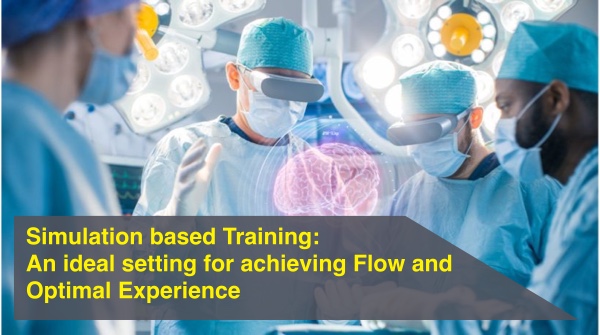As per the Flow Model, the optimal experience is wherein the person is completely absorbed in what one does and fully involved in the present moment. The person in this state is considered to be in state of “Flow” wherein there is merging of action and awareness. There is concentration on the present moment wherein the end goal is just an outcome, but what is most important and being enjoyed is the path and activity leading to it.
Particularly when the knowledge or skill in question is complex such as learning how to perform a complex surgical procedure, the path of learning is not easy. Rather it is quite painful and filled with many unpleasant experiences, complications and failures. So how is it that those experiencing such pain and failure relentlessly continue to strive and achieve success?
The optimal experience as per the Flow Model is defined as a phenomenon in which the activity itself is rewarding in and of itself, quite apart from its outcomes or any other good that can result from such activity.
Research on Flow model discusses several characteristics of an optimal experience and its conditions.
The principles of Flow have been translated into practice in a variety of contexts. This article aims to connect the model and its principles to simulation-based training.
Simulation-based training offers a very conducive environmental setting with conditions that are necessary to support achievement of optimal experience by the learners.
The interventions designed keeping in mind the principles of flow are primarily classified into two categories. One is those aimed at design of activity and environment such that they foster flow or reduce the obstructions to it and the other is those aimed at assisting the individual in finding flow.
Let us look at some of the most important factors or triggers that are considered must suitable for achievement of flow in trainees and how simulation-based training offers opportunities to optimize the training outcomes.
- Extreme focus and attention
- Clear Objectives
- Immediate Feedback
- Balance between challenge and skills
- High consequences
- Stimulating environments
- Deep embodiment
- Lateral thinking
- Informed career choice
- Extreme focus and attention: Deep concentration and involvement in the activity is an important trigger to experiencing flow. The level of realism of the simulation or the simulated scenario helps build up a high level of the degree of “suspension of disbelief”. This influences the focus and attention paid by those involved.

2. Clear Objectives: This is a feature not specific to simulation-based training but any form of training. It is especially important that the goals of any training intervention are shared along with performance expectations.
- Such expectations must be reasonable
- Performance criteria and goals must consider that each trainee is different, and some may take longer than others to reach the same level. Those who are slow to begin with does not mean that they will remain as such throughout the program. Many pick up the pace once the foundation becomes strong. Other may simply be a little slow but can and will achieve the goals when supported well.

3. Immediate feedback: This is one of the most important aspects of any training. I have always referred to “feedback” as the “fuel” for learning anything.
Simulation-based training offers an environment wherein each trainee can be provided personalized feedback.
The timing and nature of feedback can be programmed. It can be real time for performance support or set to provide formative assessment after each performance activity.
Analytics can be automated to provide insights into strengths and weaknesses. Improvement that can be seen over time in and of itself can be motivating and feed the flow.
While in gaming a comparison with peers and presenting leaderboards is common, it will be best to carefully bringing this feature into the training design. Training is not competition until one reaches a certain minimum level of competence and performance.
4. Balance between challenge and skill: The curriculum design must take care of this critical aspect of the experience design.
It must ensure that the pre-requisite knowledge and skills are confirmed to have been acquired before progression to the next phase. Further, simulation offers the advantage of teaching in a different order of tasks in comparison with real life sequence and therefore ordering them in a manner that easier tasks a presented earlier before more challenging one are faced.
The tasks can be carefully selected based on the task analysis and identification of constituent skills such that tasks can be ordered in a manner that each task builds up on those taught earlier and the skills involved do not overwhelm the trainee.
The task performance objectives can also be kept limited to specific enabling objectives before the whole task performance is expected. For instance, making a cut of a particular complex shape on the surface of a tissue is prioritized before learning and demonstrating necessary control over the size and depth of the tissue being cut.
5. High consequences: High consequences of the quality of performance can have both positive and negative influence on training. For instance, patient safety always takes highest priority in live surgical training and takes away the opportunity of learning from errors as the mentor surgeon may want to take over the task whenever the risk appears high. Simulation offers a failsafe environment to allow making errors and help reflect on why they occur and how those can be avoided. Further it also offers opportunity to manage errors and complex conditions that they generate.
6. Stimulating environments: Carefully designed simulation and simulation scenarios offer the right mix of realism with performance support and analysis features. It is a rich environment that can provide real time guidance serving as scaffolding that can be slowly withdrawn as knowledge and skills are observed to have improved. Certain features stimulate thinking and help learners in building and understanding key relationship between actions and results.
7. Deep embodiment: While simulation is used in flight training, full flight simulation is used at a specific stage of training and for well-defined objectives. It is a stage when there is deep embodiment and high level of immersion in integrated performance of all the tasks that have been learned earlier. This supports experiencing advanced scenarios and achievement of higher level of learning objectives.

8. Lateral thinking: The quality of simulation here is a necessary pre-requisite. If the simulation meets this requirement, it offers the opportunity to simulate complex and very highly variable range of scenarios.
- It is true that every patient in form of their conditions is unique in terms of stage of disease and other co-morbidities that affect the difficulty and complexity of the procedure. High fidelity simulation allows simulating and practicing a wide range of such variations making the experience extraordinarily rich and fulfilling.
- Some products on the market today even offer feeding data extracted from patient diagnostics to construct specific scenarios allowing the surgeons to practice in simulated environment and prepare fully before beginning the actual surgery. They can simulate managing specific risks or materialization of risks and how to face them successfully.
- A critical reflection on simulation of such complex cases offers an unprecedented opportunity to think laterally and make critical decisions in handling the case.
9. Informed career choice: A sound simulation system can be used to expose aspirants to experience what is expected of them and get a fair understanding of what being a surgeon means.
It can be used to help doctors make a conscious and informed choice of the career track that they will enjoy and experience flow with. It is not uncommon for residents to drop out or feel disengaged after having made a choice.
For the training system, it can also be employed for careful selection of trainees based on some prerequisite skills and other requirements associated. This can include assessment of manual dexterity and visual functions.
As can be seen, some of the factors must be considered for managing the environment conditions and characteristics while others for managing the participants that is the learners such that the training system produces the best outcomes possible.
This article is the second in the series on application of the Flow Model in Simulation-based Training.
Previous article: https://cognoscence.com/blog/blog/2020/07/13/flow-model-and-the-surgical-skills-learning-curve/
source – cover background image credit: Gorodenkoff-shutterstock
